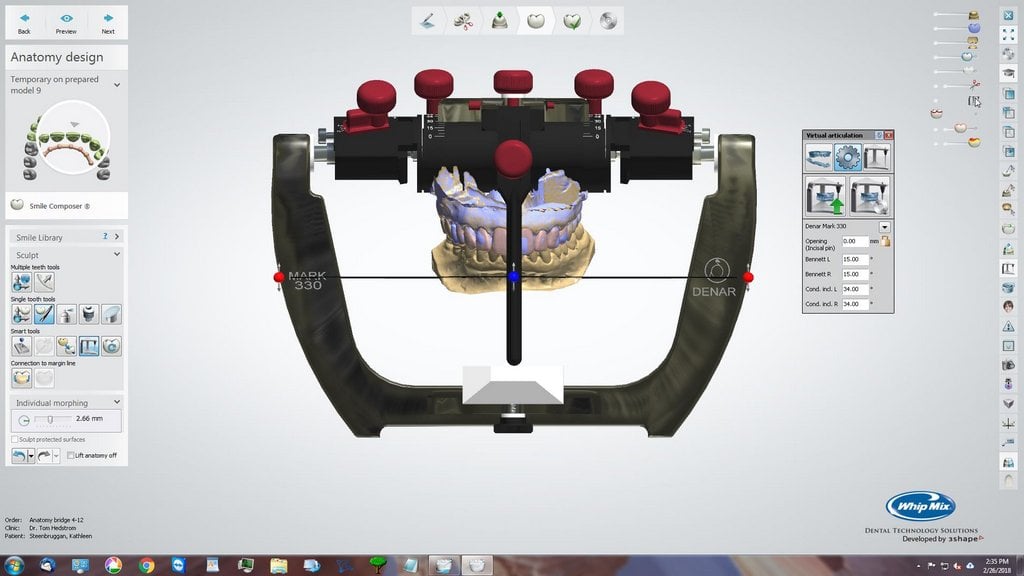Do you have 90 seconds to spare? In just 90 seconds you can decrease chair time, have less remakes, minimize occlusal adjustments and increase your production at the same time!
With an emphasis on esthetic dentistry today, now more than ever it is important to be able to provide the dental laboratory with as much patient information as possible. This becomes mission critical in those cases where you are changing the esthetics of the anterior teeth or altering the vertical dimension.
For those larger restorative cases you should use an anatomical face-bow/ear-bow. An anatomical face-bow/ear-bow record establishes the relationship of the maxillary dentition to the horizontal reference plane so that the maxillary cast can be mounted on the articulator in the correct anatomical position. And if that is not enough, studies show that most face-bows on the market can place you within 5mm of the true hinge axis.
The closer you can record the patient’s true anatomical plane of occlusion, the more accurate your final occlusion and esthetic result will be which ultimately ties into your production.
In my 26 years of experience there seems to be two common hang up’s as to why face-bow registrations are not taken. I think I have two simple solutions for both and hopefully they will inspire you to either hunt for your old face-bow or consider purchasing one.
 First of all, get over hang-up #1, “I don’t have the time”
First of all, get over hang-up #1, “I don’t have the time”
Most of you think you don’t have the time to spend on re-learning this technique and then actually taking the record. Teach your auxiliary staff to take the face-bow registration. Now, before you say that’s too important to delegate, this is the same person taking dental radiographs and primary impressions which are also very technique sensitive procedures.
It is important however to teach your auxiliary the principals behind the record itself. The technique can easily be taught and most manufacturers have some type of manual or video to refer to. It might be as easy as going to the manufacturer’s web site to download a video.
Second, get over hang-up #2, “it’s too complicated”
Every time I attend a program where face-bow technique is taught I hear the question, “what if the eyes are not parallel” or “what if one ear is higher than the other”? Well, really if we think about it, we are not talking about huge asymmetries. If you have a situation like this, pick the eye you think aligns up with the rest of the facial features and go with it. Remember you will make final adjustments in your approved provisionals. This came straight from Dr. Pete Dawson’s mouth to my ears; I sure can’t argue with that!
I think you will find that with most face-bows, the instructions will tell you to try to align the inner-pupillary line parallel with the horizontal reference plane. This will help you capture any asymmetries in the occlusal plane which we do not want to replicate in the provisionals or the final restorations. It is always a good idea to step back from the patient to confirm you are parallel with the horizontal plane. If you need to make a slight adjustment to the ear-bow, it’s better to do it while the patient is with you in the chair. Some people like to use the aid of a level to further validate the correct orientation. If you want to go one step further and make your lab happy, take a photo of the face-bow on the patient. This way your lab knows if it is the face-bow that is crooked or it is the maxilla.
Hang-up’s aside, the great news is, face-bows have been designed today with efficiency and patient comfort in mind. Some of the most popular face-bow designs come with a single toggle to lock the registration in place. Obviously only having to tighten one toggle instead of two saves time but it minimizes on confusion as to which toggle you tighten first. As far as patient comfort, there is less torque on the patients face and in the ears with the single toggle.
As far as efficiency is concerned, most of the newer designs offer an indirect mounting technique; this is the way to go! This technique allows you to remove the bite fork portion of the registration from the ear-bow. Using a jig you can mount your record to the articulator without attaching the face-bow to the articulator. This gives you more access to the cast while mounting and your ear-bow is free to take another registration if you have an extra assembly. Come to think of it, it saves money too because you only need one face-bow and a few extra bite fork accessories!
In closing just remember who we are really doing all of this for…the patient; we benefit from our patients’ satisfactions. Let a 90 second face-bow record improve your esthetic outcome, save time in your chair and make your patients’ love you for their smile!











.png)

Leave a comment